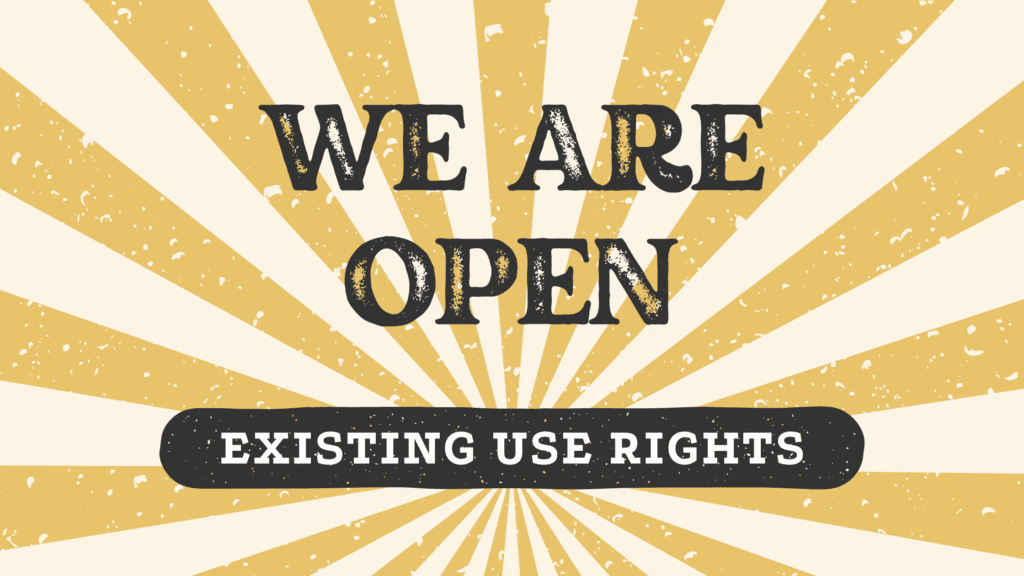12 Jul Existing Use Rights

The basis for existing use rights came about from common law. It is based on the principle that it would be unfair for the planning scheme to change and make someone’s use or livelihood suddenly be unlawful. Once an existing use right is established it may continue without requiring further approval.
For existing use rights to be established it is generally required to demonstrate that the use has been continuously operating for 15 years. It is also possible to demonstrate that the use was lawfully operating just prior to the introduction of the new format planning scheme, but as this is from around 1999 to 2000, this is often more difficult than demonstrating 15 years of use.
If you are wanting to try to establish existing use rights on your land what are the steps you will need to go through:
Defining the Use
The first thing to do is to define the activities occurring on site.
Defining the existing use should be with an ‘actual’ use, not by fitting the activities into the definitions of the planning scheme. In describing the activities, descriptions that use common or real world definitions are what should be relied upon.
Demonstrating The Use
Next there is the need to demonstrate 15 years of continuous use.
It is important to be aware that this can be quite challenging to establish. The burden of proof is with the property owner to establish that 15 years of continuous use has occurred. For this to be demonstrated there is usually a need for a range of different evidence to be provided. The types of information varies depending on the specific use, but information such as insurance details, supplier invoices, utility or other bills, marketing or advertising material, copies of leases or licences, Council records and statutory declarations from former owners, clients or staff are examples of commonly used evidence. This evidence should span the 15 years in order to demonstrate that the use has been operating throughout that time.
Expiration
It is important to realise that existing use rights can be extinguished.
A use that has stopped for a continous period of 2 years, or has stopped for two or more periods which together total 2 years in any period of 3 years. In the case of a seasonal use, the use would expire if it doesn’t take place for 2 years in succession.
Once an existing use has expired the planning scheme requirement apply to the land and so a planning permit is required for any activities that need approval and any activities that are prohibited can’t be allowed.
Intensification of Use
One area I have researched is the notion of intensity of the use over time. There have been many prior VCAT discussions that have demonstrated that a change to the scale or intensity of the use is allowable under existing use rights. However, a change in the scale/intensity of the use must not:
- Result in a transformation of the use or how it would be defined in normal terms. For example a pub changing its activities to include a significant numbers of music events and morphing into a nightclub use (as happened at the iconic Lemon Tree in Parkville).
- Damage the amenity of the area by a change in activity beyond the limited scope of the existing use rights.
Recently there was a VCAT decision which found that if a venue had existing use rights for a liquor licence, then a change to the hours of the venue (something that usually triggered a planning permit under Clause 52.27) would not require a planning permit. The VCAT decision is Kevak Hotels Pty Ltd v Darebin CC [2022] VCAT 318. The Tribunal Member found that to require a planning permit would constrain the scope of existing use rights and not allow them to intensify over time as they are allowed to do within the parameters of the established existing use rights principles.
Alternative Uses
Under the Existing Use Rights Clause there is scope to allow an alternative non-compliant use to be permitted. This allows for a planning permit to be issued to authorise a normally prohibited use, if it can be demonstrated that the alternative use is less detrimental to the amenity of the area. In order to do this, you would need to satisfy the test to demonstrate existing use rights and then provide evidence of how an alternative use would be better for the area than the existing use.
How to Apply
There are two ways that you can apply. You can seek a Certificate of Compliance from the Council or you can request a declaration from the Victorian Civil and Administrative Tribunal (VCAT) to confirm if there are existing use rights on a site. Either process requires similar evidence to support the application. For both processes the decision maker needs to be satisfied that sufficient information has been provided both to define the activities on site and to demonstrate that they were established for a continuous 15 year period.
Overall establishing existing use rights can be a tricky and complex procedure. If you are looking to establish an existing use it is worth first considering whether you can obtain the necessary documentation to support your claim and then speaking to a planning professional or lawyer for further advice.

